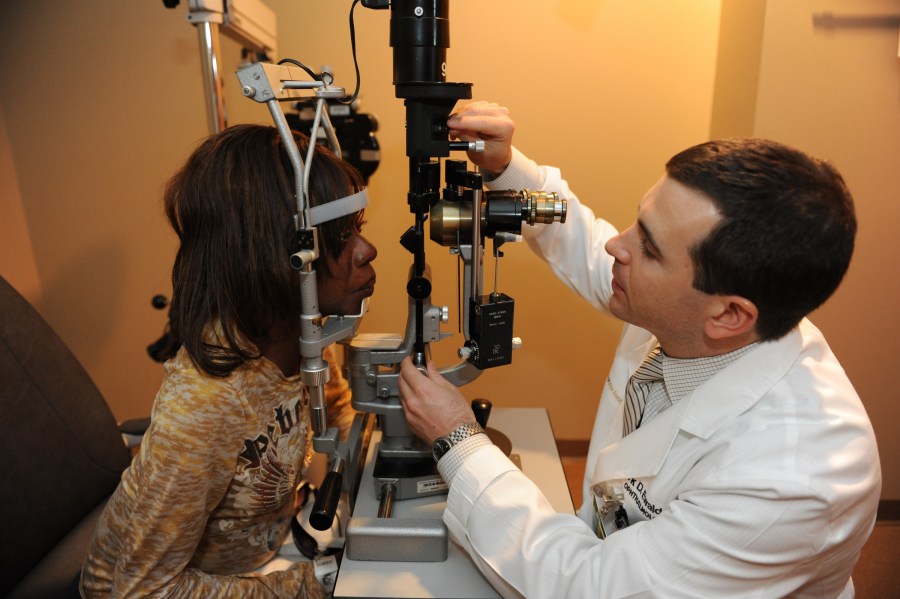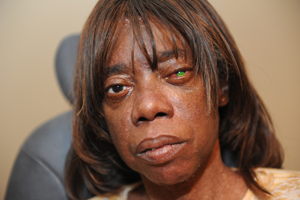
Mark Ewald, M.D., examines patient Rita Coffee at the Vanderbilt Eye Institute. (photo by Joe Howell)
Risks of non-prescription contact lenses revealed
Rita Coffee never thought a $25 pair of cosmetic contact lenses could potentially cost her something far more valuable – her eyesight.
After experiencing severe pain, burning, swelling and discharge from her left eye, the 47-year-old Nashville resident came to Vanderbilt University Medical Center.
Coffee had developed an infectious corneal ulcer caused by her contact lens. Although ophthalmologists at the Vanderbilt Eye Institute treat patients for contact lens-related ulcers, Coffee is among a growing number of new cases – consumers who purchase contact lenses without a prescription.
“It is illegal to distribute contact lenses without a prescription,” said Mark Ewald, M.D., the ophthalmologist treating Coffee. “It is very important to have a prescription for any kind of contact lens because improper use can lead to infection and other complications.
“Even though many people wear contact lenses with a high amount of satisfaction and problem-free use, there are risks. It is vital that users have regular eye exams and a proper fitting at the time of lens distribution,” said Ewald, assistant professor at VEI.
In 2005, contact lenses were classified as medical devices under the Federal Food, Drug and Cosmetic Act. The classification called for all contact lenses, worn for any purpose, to require a valid prescription and that the lenses could not be sold to a consumer without one.
Unaware of the law, Coffee has been purchasing her contact lenses without a prescription since 1986. Not a daily wearer, she estimated she used them several times a week.
“I bought mine at a local beauty supply store, but people can get them online too,” said Coffee. “They have all different colors and designs.
“But I did not know I needed a prescription to buy them and the clerks didn’t tell me that either.”
It’s something she wished she had known. In a matter of 24 hours, she went from thinking she was experiencing sinus and allergy symptoms to having an ophthalmologic emergency.
“I was crying and walking the floors it was hurting so badly,” said Coffee. “Even now I cannot sit in the light and my vision is very blurry in that eye."

Rita Coffee developed an infectious corneal ulcer caused by her non-prescription contact lenses. (Photo by Joe Howell)
Coffee said she will never use non-prescription contact lenses again.
“I have been telling other people – if your doctor has not prescribed them, leave contacts alone,” she said.
Coffee is angry that retailers are selling the decorative/cosmetic lenses without requiring a valid prescription.
“I could have lost not only my eyesight, but my eye,” Coffee said. “I just had no idea I was doing something that could cause me harm.”
VEI specialists say the use of decorative/cosmetic contact lenses is widespread and should not be viewed as a beauty accessory.
“Contact lenses are one of the safest forms of vision correction,” said Jeff Sonsino, O.D., assistant professor at VEI. “The lenses themselves are not dangerous. But people need to understand there are risks, and the best way to avoid some of these problems is to visit an eye doctor. Patients who wear contact lenses for any use need to be monitored.”
VEI specialists suggest consumers interested in contact lenses:
• Get an eye exam from a licensed professional;
• Get a valid prescription that includes brand name and lens dimensions;
• Purchase lens from a vendor that requires a prescription; and
• Follow directions for cleansing, disinfecting and wearing lenses.













